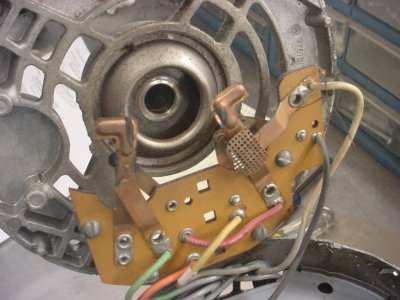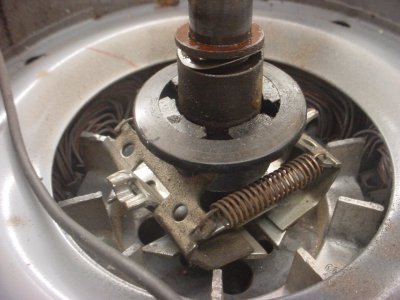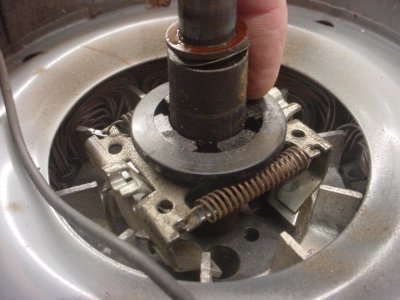- Joined
- Dec 25, 2011
- Messages
- 10,511
It is just barely conceivable that the last time that you turned the motor off that there was a charge left in the Start capacitor. It is unlikely that any is left by now but if you want to be certain, unplug the line cord, turn the motor switch ON and with an insulated screwdriver, shor the two flat pins of the male plug together. Assuming that the centrifugal switch has closed by now, that will discharge the capacitor.
Other than that, there is nothing else in the motor to worry about.
I haven't seen a good photo of the bearing carrier on the wiring end of the motor to see whether the bearing end is open or not but after you pull the nuts off of the four long tie-bolts, I would cut some blocks or spacers and jam them in between the motor pulley and the pulley end of the motor to ensure that when you pry the wiring end bearing carrier out of the motor body that the armature doesn't pull out of the wiring end of the motor. There will be some wires that will follow the bearing carrier as you separate it from the motor body. Be careful of those. Part of the centrifugal mechanism will be attached to the armature and part of it including the switch itself will be attached to the bearing carrier. There will be a flat metal disk attached to the arms on the armature that moves towards the switch as the motor speed comes up. It will push on the switch actuator opening the switch. If it looks like it moves, oil it! And tight is good enough.
Other than that, there is nothing else in the motor to worry about.
I haven't seen a good photo of the bearing carrier on the wiring end of the motor to see whether the bearing end is open or not but after you pull the nuts off of the four long tie-bolts, I would cut some blocks or spacers and jam them in between the motor pulley and the pulley end of the motor to ensure that when you pry the wiring end bearing carrier out of the motor body that the armature doesn't pull out of the wiring end of the motor. There will be some wires that will follow the bearing carrier as you separate it from the motor body. Be careful of those. Part of the centrifugal mechanism will be attached to the armature and part of it including the switch itself will be attached to the bearing carrier. There will be a flat metal disk attached to the arms on the armature that moves towards the switch as the motor speed comes up. It will push on the switch actuator opening the switch. If it looks like it moves, oil it! And tight is good enough.




